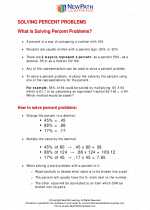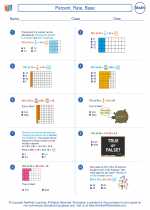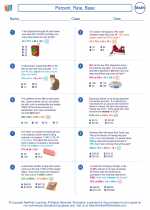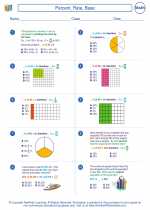Percent, Rate, Base
Understanding percent, rate, and base is essential in various mathematical and real-life contexts. In this study guide, we will cover the basics of percent, rate, and base, and provide examples to help you grasp these concepts.
Percent
Percent means "per hundred" and is denoted by the symbol "%". It is used to express a number as a fraction of 100. For example, 25% is equivalent to the fraction 25/100 or the decimal 0.25.
Rate
A rate is a special ratio in which the two terms are in different units. For example, miles per hour (mph) is a rate. It compares the distance traveled to the time taken. Rates are often expressed using the word "per" or the symbol "/", such as 60 miles per hour or 60 mph.
Base
The base is the original value in a percent problem. It is the whole or the original amount before a percentage is calculated. For example, if you're calculating 20% of 80, then 80 is the base.
Key Formulas
The following formulas are essential when dealing with percent, rate, and base:
Percent = (Part / Whole) * 100
Examples
Let's work through a few examples to illustrate these concepts:
Example 1: Calculating Percent
If you scored 35 out of 50 on a test, what is your score as a percentage?
Percent = (35 / 50) * 100 = 70%
Example 2: Calculating Rate
If a car travels 300 miles in 5 hours, what is its speed in miles per hour?
Rate = 300 miles / 5 hours = 60 mph
Example 3: Finding the Base
If 15 is 20% of a number, what is the original number?
Base = 15 / 0.20 = 75
Study Tips
When studying percent, rate, and base, it's helpful to practice converting between fractions, decimals, and percentages. Additionally, working through real-life problems involving discounts, taxes, and tips can improve your understanding of these concepts.
Remember to use the key formulas and units to guide your problem-solving process. Understanding the relationship between percent, rate, and base will also make it easier to solve problems in various scenarios.
By mastering percent, rate, and base, you'll develop a valuable skill set for handling a wide range of mathematical and practical situations.
Good luck with your studies!
.◂Math Worksheets and Study Guides Sixth Grade. Percent, Rate, Base

 Worksheet/Answer key
Worksheet/Answer key
 Worksheet/Answer key
Worksheet/Answer key
 Worksheet/Answer key
Worksheet/Answer key
